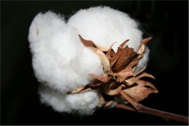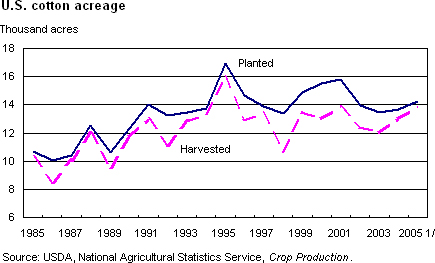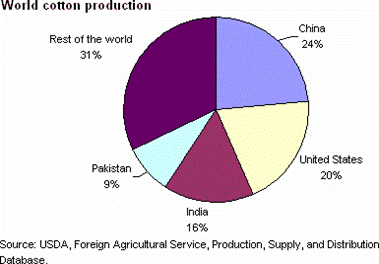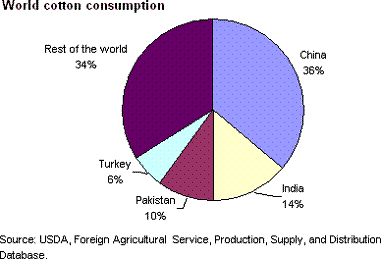 |
The U.S. cotton industry generates more than 400,000 jobs among the
various sectors from farm to textile mill and accounts for more than
$40 billion in products and services annually. Cotton is produced in
17 southern States from Virginia to California. Major concentrations
include areas of:
- the Texas High and Rolling Plains;
- the Mississippi, Arkansas, and Louisiana Delta;
- California's San Joaquin Valley;
- Central Arizona; and
- Southern Georgia.
|
The U.S. cotton industry generates more than 400,000 jobs among the
various sectors from farm to textile mill and accounts for more than
$40 billion in products and services annually. Cotton is produced in
17 southern States from Virginia to California. Major concentrations
include areas of:
- the Texas High and Rolling Plains;
- the Mississippi, Arkansas, and Louisiana Delta;
- California's San Joaquin Valley;
- Central Arizona; and
- Southern Georgia.
U.S. cotton is grown as an annual from seed planted each year,
although cotton can be grown as a perennial in tropical climates.
Given the vast differences across the U.S. production area, the
cotton growing season varies dramatically, as typical planting
occurs between March and June and usual harvesting occurs between
August and December.
The predominant type of cotton grown in the United States is
American Upland (Gossypium hirsutum). The upland type, which usually
has a staple length of 1 to 1 1/4 inches, accounts for about 97
percent of the annual U.S. cotton crop. Upland cotton is grown
throughout the U.S. Cotton Belt as well as in most major
cotton-producing countries. The balance of U.S.-grown cotton is
American Pima or extra-long staple (ELS) (Gossypium barbadense). ELS
cotton, which has a staple length of 1 1/2 inches or longer, is
produced predominantly in California, Arizona, New Mexico, and
southwest Texas, where it is particularly well adapted to the arid
environmental conditions. The markets for ELS cotton are mainly
high-value products such as sewing thread and expensive apparel.
Cotton acreage in the United States rose slightly during the 1990s
from the previous two decades. In the 1970s and 1980s, area planted
to cotton averaged about 12 million acres. Area rose to about 14
million acres in the 1990s, and has averaged slightly higher since
then. Most the growth in area has been in the Southeast, in part
reflecting the cost-reducing impact of boll-weevil eradication.

According to the Census of
Agriculture, U.S. cotton farms numbered 24,805 in 2002, down from
33,640 in 1997. While the number has fallen, cotton acreage per farm
has risen. As a result, the number of large cotton farms (over 1,000
acres) has continued to increase while the number of small cotton
farms (under 100 acres) declines.
Like area, cotton
production in the United States during the 1990s rose above the previous
two decades, paralleling advances in technology (seed varieties,
fertilizers, pesticides, and machinery) and production practices
(reduced tillage, irrigation, crop rotations, and pest management
systems). In recent years, the impact of these changes has been
particularly evident, with yields reaching new highs.
Consumption of
cotton by U.S. textile mills also rose during the 1990s, but peaked in
1997. Since then, U.S. mill use of cotton has plummeted, dropping about
50 percent by 2005. While the end of the Multifibre Arrangement’s (MFA)
quotas in 2005 was a factor in this decline, much of the decline in U.S.
textile production occurred before then. U.S. consumer demand for cotton
has continued to grow, but imported clothing now accounts for most
purchases by U.S. consumers.
The world's four
largest cotton-producing countries are China, the United States, India,
and Pakistan, which together account for nearly 70 percent of world
production. Other major producers include Uzbekistan, Brazil, and
Turkey. Turkey is the fourth largest consumer of cotton in the world
behind China, India, and Pakistan (bumping the United States to fifth
place among consuming nations). Like Turkey, Brazil is also a major
cotton-consuming country, but is increasingly exporting cotton to the
world market, while Turkey’s imports have grown. While cotton is
generally a Northern Hemisphere crop, about 10 percent of the world's
output comes from south of the equator (primarily Brazil and Australia)
and is harvested during the Northern Hemisphere's spring.


Trade is
particularly important for cotton. More than 30 percent of the world's
consumption of cotton fiber crosses international borders before
processing, a larger share than for wheat, corn, soybeans, or rice.
Through trade in yarn, fabric, and clothing, much of the world's cotton
again crosses international borders at least once more before reaching
the final consumer.
The cotton industry
continues to face many of the supply and demand concerns confronting
other field crops. However, since cotton is used primarily in
manufactured products, the industry faces additional challenges
associated with the economic well-being of downstream manufacturing
industries.
Cotton Commodity
Information:
Minimum Price
Movement for Cotton Futures
1/100 of a cent
(one "point") per pound below 95 cents per pound. 5/100 of a cent (or
five "points") per pound at prices of 95 cents per pound or higher.
Spreads may always trade and be quoted in one point increments.(point
value of $5/contract)
Daily Price
Limit for Cotton Futures
3 cents above or
below previous day's settlement price. However, if any contract months
settles at or above $1.10 per pound, all contract months will trade with
4 cent price limits. Should no month settle at or above $1.10 per pound,
price limits stay (or revert) to 3 cents/lb. Spot month - no limit on or
after first notice day.
Last Trading Day
for Cotton Futures
Seventeen business
days from end of spot month.
First Notice Day
for Cotton Futures
Five business days
before the first notice day of the spot contract month.
Last Notice Day
for Cotton Futures
Twelve business
days from end of spot month.
Contract
Symbol for Cotton Futures
CT
Cotton Futures Contract Size
50,000 pounds net weight
Cotton Futures Contract Months
March, May, July,
October, December (Current month plus one or more of the next 23
succeeding months)
Contract Settlement
Physical
Delivery
Cotton Futures Trading Hours
10:30 am to 2:15
pm; pre-open commences at 10:20 a.m.; closing period commences at 2:14
pm (electronic trading hours: 1:30 a.m. - 3:15 p.m. ET)
Price Quotation
Cents and hundredths of a cent per
pound
|








